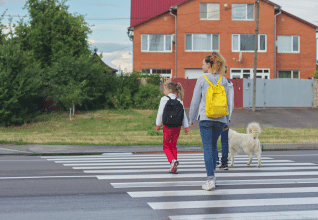As a pedestrian on Irish roads, your safety depends on both your actions and those of drivers. This guide, part of the Irish Road Safety Week 2024 campaign, offers essential tips and insights to help you navigate streets safely.
Pedestrians as Road Users
Pedestrians are among the most vulnerable road users.
Unlike drivers, pedestrians and cyclists rely entirely on their awareness and good road safety practices to keep themselves and others safe. Being alert, visible, and following road safety advice can significantly reduce the risk of accidents.
Key Points:
- Vulnerability: Pedestrians have no physical protection in the event of a collision.
- Awareness: Staying vigilant helps in anticipating and avoiding potential dangers.
- Responsibility: Both pedestrians and drivers share the duty to ensure road safety.
Understanding your role and responsibilities as a pedestrian is crucial for preventing accidents and ensuring safe journeys.
Tips for Pedestrians & Drivers on Irish Roads

Pedestrians must exercise good judgement, take reasonable precautions and practise good road safety to avoid putting themselves (or others) in danger, and to avoid being an inconvenience to other road users.
Likewise, motorists should take precautions and stay alert in order to avoid causing harm or putting pedestrians at risk. Below are some tips for both drivers and pedestrians.
For Pedestrians:
- Stick to the Footpath: If there is a footpath available then pedestrians must use it. When there is no footpath, pedestrians must stay as close as possible to the right-hand side of the road, facing oncoming traffic.
- Respect Other Road Users: As a pedestrian, you should always be aware of other road users and avoid putting others in harm’s way.
- Obey Traffic Signals: Always follow pedestrian signals at crossings.
- Walk in Single File: On roads that narrow or carry heavy traffic, pedestrians should walk in single file and no more than two abreast.
- Stay Safe, Stay Seen: Pedestrians should always wear high-visibility clothing during the day and reflective clothing when at night.
For Drivers:
- Yield to Pedestrians: Drivers must give way to pedestrians at crossings and intersections.
- Speed Limits: Adhering to speed limits, especially in areas with high foot traffic, enhances pedestrian safety.
- Awareness: Stay alert for pedestrians, especially in urban or residential areas and near school zones.
Safe Crossing Practices
When crossing the road, pedestrians should be mindful of the potential dangers from cars and traffic. Proper crossing techniques can prevent accidents and ensure you get to where you’re going safely.
Best Practices:
- Find a Safe Place to Cross: Always cross at marked crossings, footbridges, or underpasses where available. Avoid crossing at corners or bends where oncoming drivers may not see you.
- Look Both Ways: Before crossing, check for oncoming traffic from both directions and listen for signs of cars or traffic. Never cross near parked vehicles or step out into the road. When crossing, you should stay alert and be on the lookout for traffic while you cross.
- Look Out for Buses & Trams: Take care when crossing the road when there is a bus lane, bus stop or a tram line. You should also never cross in front of a stopped bus and be mindful when getting on or off public transport.
- Avoid Distractions: Keep your focus on the road by putting away mobile phones and removing headphones that can cause unwanted distractions.
- Make Eye Contact: Ensure drivers see you and are aware of your presence before stepping into the road.
Pedestrian Safety at Night
Walking at night presents unique challenges. Reduced visibility can make pedestrians harder to see and increase the risk of accidents. Taking extra precautions can enhance your safety after dark.
Safety Tips:
- Wear Reflective Clothing: Bright and reflective gear makes you more visible to drivers and will be seen from a distance.
- Use Lights: Carry a flashlight or wear a headlamp to illuminate your path.
- Choose Well-Lit Routes: Stick to streets and paths that are adequately lit to increase visibility.
- Stay Alert: Pay extra attention to your surroundings and watch for oncoming traffic.
Pedestrian Safety for Children
Children are especially vulnerable pedestrians due to their size and developing judgement.
In fact, research by the RSA shows that children do not develop the ability to safely interact with traffic until they are 12 years old. This is why they need the help and supervision of an adult to safely cross the road.
Safety Guidelines for Kids:
- Supervise Young Children: Always watch your children closely when walking near roads.
- Teach Road Safety Rules: Educate children on how to use crossings, obey signals, and stay alert.
- Use Child-Friendly Crossings: Where available, use crossings designed with children in mind, such as those with audible signals.
- Equip with Reflective Gear: When walking in low light or dark conditions, children should wear bright or reflective clothing so they are visible to drivers and motorists.
The RSA also provides a list of simple suggestions that drivers can use to keep children safe around schools on their website.
Pedestrian Distractions
Modern technology and lifestyle can lead to distractions that compromise pedestrian safety. Reducing distractions helps you stay alert and responsive to potential hazards.
Common Distractions:
- Mobile Phones: Using phones while walking takes your attention away from the road.
- Headphones: Listening to music or other audio can make it difficult to hear traffic sounds, such as approaching cars or vehicles.
- Multitasking: Engaging in activities like eating or reading while walking can split your concentration and reduce awareness of your surroundings. .
Safety Measures:
- Limit Device Use: Keep mobile phone usage to a minimum when near roads.
- Use One Earbud: If you absolutely have to listen to music or podcasts while out, consider using only one earbud to stay aware of your surroundings.
- Stay Focused: Prioritise paying attention to traffic and your environment over other activities.
Sharing Roads & Footpaths
Sharing the road and other spaces like footpaths requires cooperation and awareness from both pedestrians, motorists and cyclists.
Here are some tips and suggestions.
Key Practices:
- Stay on Footpaths: Use designated walkways to keep clear of vehicles and traffic from cyclists.
- Face Traffic When No Footpath: If footpaths are unavailable, walk on the right-hand side of the road facing oncoming traffic to better see approaching vehicles.
- Be Aware of Cyclists: In shared spaces, give cyclists plenty of room and be mindful of their speed and direction. Cyclists will typically travel faster than someone on foot so it’s important everyone in the situation does their best to avoid collisions.
- Respect Shared Areas: Whether on footpaths or shared roads, courteous behaviour enhances safety for everyone.
FAQs
Road Safety Guide for Pedestrians

Written by KennCo Staff
Approved by Marketing Manager Noel Gavin
